The atmosphere of Uranus, while sharing a similar chemical makeup with other gas giants, possesses unique characteristics. These characteristics pertain to the structure of the atmosphere and the various processes taking place within each of its regions. The abundance of ice and the presence of multiple cloud layers, each with its own distinct chemical composition, contribute to the distinctive atmospheric environment found on Uranus.
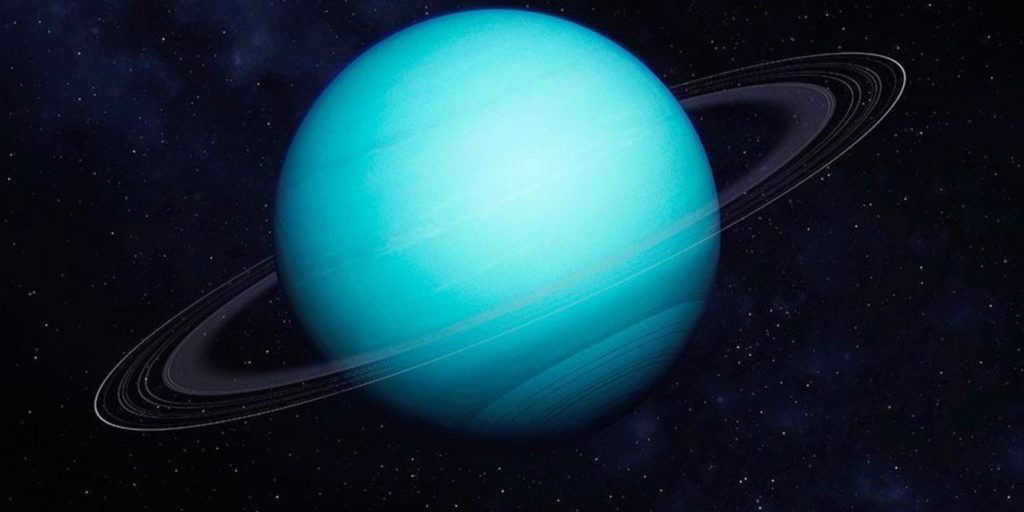
Background information about the development of the atmosphere
The appearance of the celestial body’s atmosphere is determined by the physical characteristics, which are influenced by the properties and characteristics of the planet’s core. The formation process of the core is a crucial factor.
During the celestial body’s formation, the core of Uranus was incapable of accumulating and retaining a significant amount of hydrogen and helium in its vicinity. This is because, by the time the central part of the planet had gained enough mass, these elements were scarce in the solar system.
Composition of Uranus’ Atmosphere
One interesting characteristic of Uranus’ atmosphere is its layered structure. The outermost layer is primarily composed of methane gas, which absorbs certain light waves and gives the planet its distinctive blue-green color. This layer selectively absorbs light waves corresponding to shades of red.
In terms of chemical composition, Uranus is similar to other gas giant planets in the solar system. However, its atmosphere stands out due to its higher concentration of ice.
Scientists have determined this by measuring the temperature on Uranus’ surface and in its lower atmosphere, which registered a frigid -224 °C. This makes Uranus the coldest atmosphere in the entire solar system.
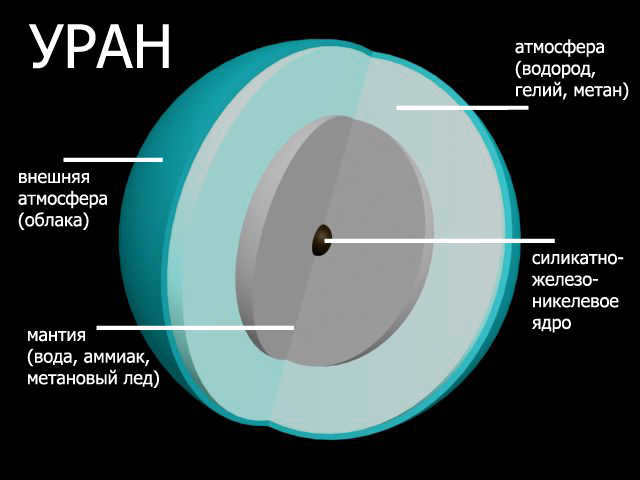
The atmosphere of Uranus is typically categorized into the following regions:
- The troposphere, which extends from -300 to 50 km (with 0 representing the level at which the pressure is 1 bar, similar to the concept of “sea level” on Earth);
- The stratosphere, which extends up to 4000 km;
- The thermosphere, also referred to as the “atmospheric corona”, with a maximum height of 50000 km, where the pressure approaches zero;
- The region of the stratosphere that borders the thermosphere and the atmospheric corona is known as the ionosphere. Its density is influenced by the activity of the Sun and is higher compared to other gas giants.
There is a minimum of 8000 km in the total thickness of Uranus’ atmospheric environment.
Chemical makeup
In the upper atmosphere of Uranus, methane exists in the form of ice crystals and vapor, concealing the storms that occur in the lower layers. Additionally, there are indications of ammonia in the upper regions of the Uranian environment.
Experts believe that the presence of ethane in trace amounts in the upper atmosphere is a result of methane undergoing photolysis due to ultraviolet solar radiation. Along with other, more complex hydrocarbons, it contributes to the formation of a thick haze.
Through spectroscopy, it has been determined that water vapor, carbon monoxide, and carbon dioxide enter Uranus’ atmosphere from external sources, such as passing celestial bodies like comets.
The Voyager 2 spacecraft confirmed the composition of this gas, transmitting spectrographic data back to Earth in 1986. Before this, it was believed that the ice giant’s atmosphere consisted only of hydrogen and methane.

Clouds on Uranus
The clouds on Uranus can be found in the troposphere, which is the most active part of the planet’s atmosphere. They are categorized into four layers, each with its own unique composition:
- The first layer is situated at a pressure level of 1.2 bars and consists primarily of methane.
- Ammonia and hydrogen sulfide clouds can be found in the troposphere layer at a pressure range of 3-10 bars.
- A cloud layer composed of ammonium hydrosulfide forms at a pressure range of 20-40 bars.
- Water clouds made up of ice crystals are located at a pressure level of 40-50 bars. There is speculation that similar cloud formations may exist in higher atmospheric pressure levels, ranging from 50 to 100 bars.
The bands of clouds on Uranus move at a high speed and are difficult to observe due to the methane haze that surrounds the planet. Space researchers can only directly observe the two highest groups of clouds on Uranus.
Studying these clouds allows scientists to draw conclusions about seasonal phenomena and wind speeds on the planet, which can reach up to 250 m/s. However, layers below a depth of 300 km are still inaccessible for detailed study.
Uranus is a planet in our solar system that was discovered during a time of great advancements in astronomy, following the invention of the telescope. Prior to its discovery, mankind was aware of the existence of only six planets.
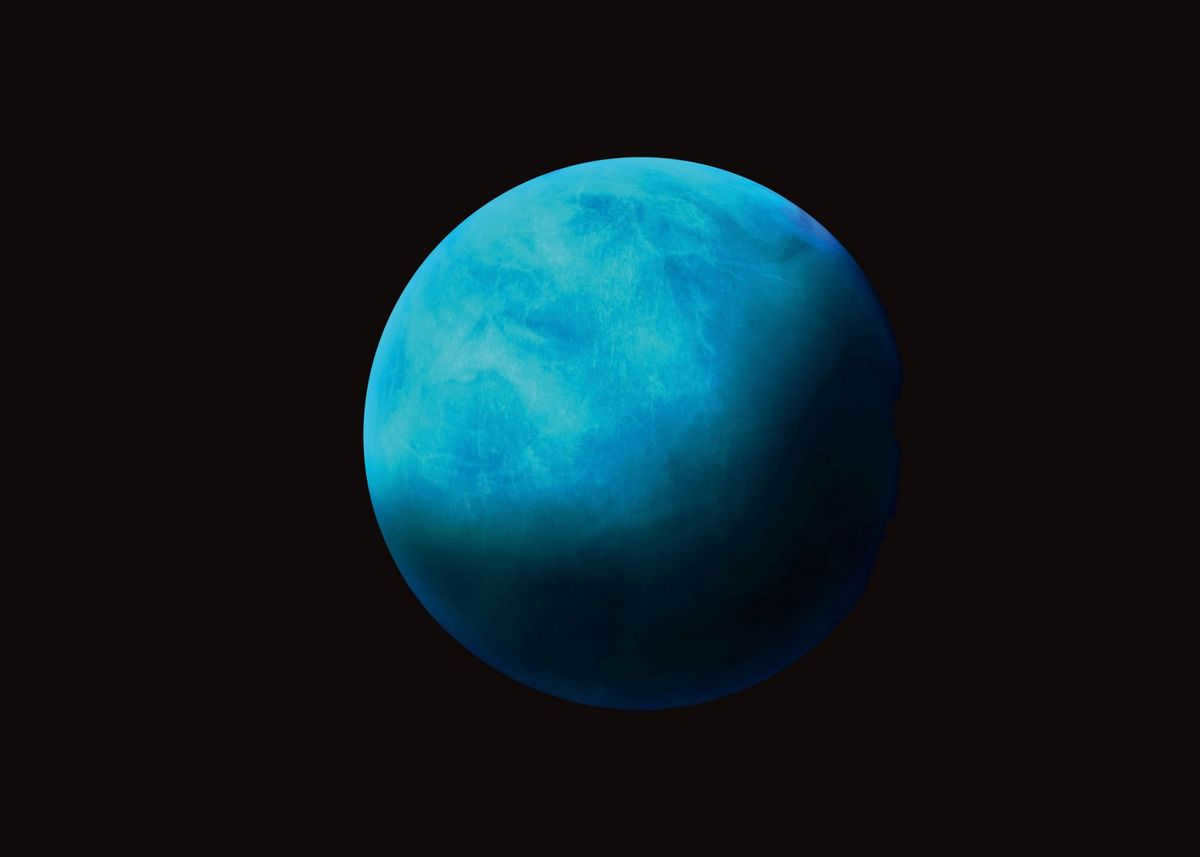
Discovery History of Uranus
The initial mention of the celestial body, subsequently known as Uranus, can be traced back to the records of J. Flemsteed. He first observed it in 1690, but mistakenly identified it as a star and assigned it to the Taurus constellation. Throughout the 18th century, the planet was observed by the French astronomer Le Monnier for approximately 20 years, who also labeled it as a star on astronomical charts.
In 1775, a musician and amateur astronomer named W. Herschel, who was originally from Germany but lived in Bath near Bristol, England, started examining celestial objects using a handmade telescope. As he moved his observations across the sky, he eventually came across a group of stars in the constellation Taurus in March 1781. One star in particular caught his attention, as it was located in a place where it was not expected based on previous maps.
This object appeared as a small disk rather than a bright point, and it seemed to be gradually shifting in relation to the other stars. Herschel proposed that this celestial body could be either a star surrounded by a nebula or a comet, but he was more inclined towards the latter possibility. In May of the same year, Andrei Lexel, an academician from St. Petersburg, began calculating the orbit parameters of this object.
Notwithstanding, astronomers adhered to the designation “Uranus,” appropriated by the German scholar Johann Bode from folklore – henceforth in the Greek pantheon denoted as the deity of the heavens. This appellation was officially bestowed upon the seventh celestial body of the heliosphere by the World Astronomical Society in 1860.
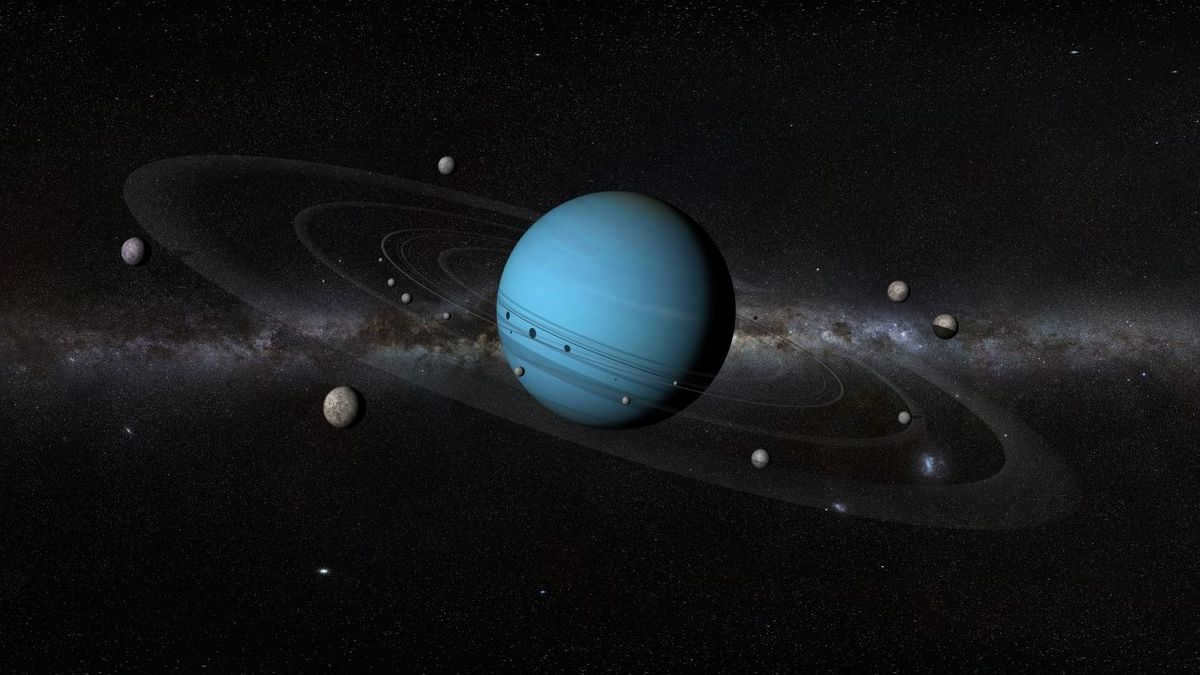
In addition to the planet Uranus itself, Sir William Herschel made the groundbreaking discovery of two of its largest moons, namely Titania and Oberon, in the year 1787. Later on, in 1851, an astronomy enthusiast and brewer named William Lassel discovered two more satellites, Ariel and Umbriel. The fifth moon, Miranda, was subsequently discovered in 1948 by the American astronomer Gerard Kuiper. It is worth mentioning that Kuiper was also an amateur astronomer prior to his groundbreaking discoveries. Finally, in the 1980s, the world was astounded by the revelation of the existence of the majestic rings encircling the planet Uranus.
Physical characteristics
The seventh planet in our solar system is also one of the largest. It comes second only to Jupiter and Saturn in terms of size. Uranus possesses the following physical characteristics:
- mass – 8.69 × 10^25 kg;
- volume – 6.8 × 10^13 m³;
- density – 1.27 g/cm³;
- diameter at the equator – approximately 51,120 km, between the poles – about 50,000 km;
- orbital velocity – 6.8 km/second;
- apparent stellar magnitude – 6;
- average distance between the planet and the sun – 2.8 billion km (20 a.u.).
The rotation period of Uranus around its axis is slightly over 17 hours, and the motion itself is clockwise, known as retrograde.
This enormous celestial body is positioned almost flat within its orbital path (with its axis inclined at a 98-degree angle to the orbital axis), giving it the appearance of rolling around the Sun rather than rotating like the other planets.
Composition of the planet
Experts classify Uranus and Neptune as a unique category of planets known as ice giants, as they lack metallic hydrogen in their cores and instead possess a significant amount of high-temperature forms of ice. Deep within the seventh planet, alongside ice crystals, there are also rocks. In terms of its chemical makeup, the planet’s mantle can be described as a water-ammonia ocean with traces of methane.
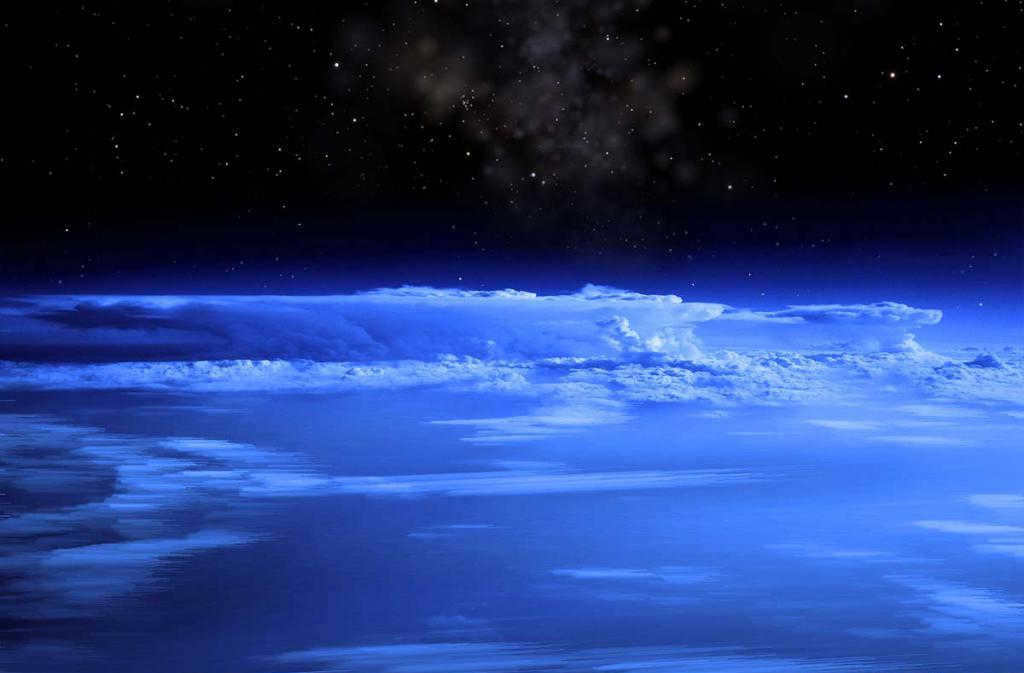
Uranus’s Composition
The composition of Uranus includes the planet itself, along with its satellites and rings. There have been recent confirmations of the existence of 13 ring-shaped formations, which are significantly younger than the planet. It is possible that these rings are remnants of previously captured objects. The rings surrounding Uranus are both narrow and dark. The largest particles that make up these rings are no larger than 1 meter in size.
Structurally, Uranus can be divided into three main components:
- The first component is the solid core of the planet, which is incredibly hot, reaching temperatures of up to 5000°K.
- The second component is the mantle, which is composed primarily of ice. This ice is not ordinary water, but a modified form that contains significant amounts of methane and ammonia.
- The third and outermost component is the shell, which is primarily composed of hydrogen and helium in their gaseous state.
Out of these three components, the mantle is the largest, occupying approximately 60% of Uranus’s structure.
Gravity and magnetic field
Scientists have determined that if an object were to fall from above onto the surface of Uranus, it would reach a velocity of 8.69 m/second². This is due to the fact that despite being a much heavier planet than Earth, Uranus has a lower gravity. This is because the strength of gravity on a celestial body is determined by its mass as well as its density, and Uranus is considered to have a low density compared to other planets in the Solar System, ranking second to last in this parameter.
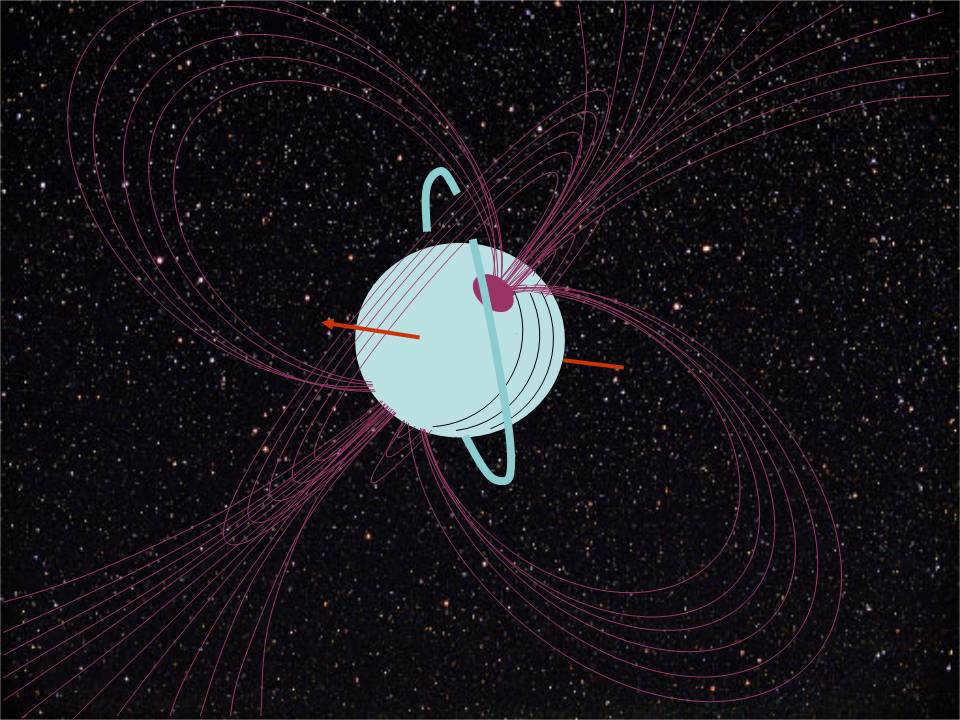
The magnetic field of Uranus is generated in the mantle, rather than the typical scenario where it forms at the planet’s geometric center. Furthermore, the magnetic field is not evenly distributed throughout the entire planet, but only in certain areas. The axis connecting the magnetic poles is not aligned with Uranus’ rotational axis but is instead inclined at an angle of 59°.
As a result, the geographic poles and the magnetic poles of Uranus are offset from each other by approximately one-third of the planet’s radius.
This unique configuration leads to an uneven distribution of magnetic field strength across different points on the planet’s surface, resulting in the occurrence of aurora borealis phenomena far away from the geographic poles.
Atmosphere and Surface Topography
Uranus, the seventh planet in our Solar System, does not have a lithosphere in the traditional sense, resulting in a lack of pronounced surface features. Instead, there exists a fuzzy boundary between the planet’s mantle and stratosphere, where the transition from liquid to gaseous layers occurs. With temperatures dropping to -49°K (-224°C), Uranus is considered the coldest planet in our star system.
In images captured in the visible spectrum approximately 30 years ago, Uranus appeared devoid of the atmospheric storms commonly seen on other gas giant planets. However, as the planet approaches the equinox point, there has been an increase in weather activity, including wind speeds reaching up to 250 m/second (900 km/h) over the icy ocean.
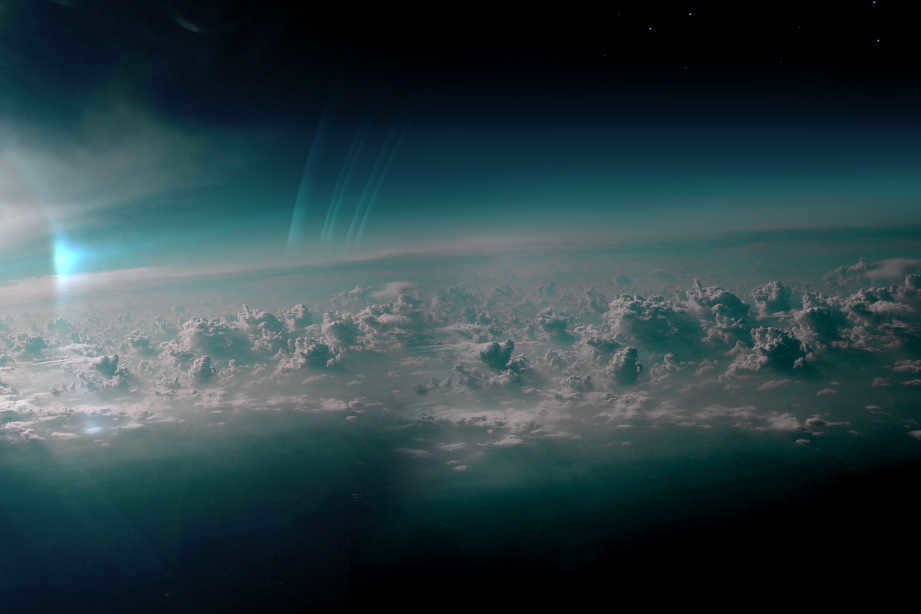
According to spectral analysis, the composition of Uranus’ atmosphere is primarily made up of hydrogen (82%) and helium (16%), with a small percentage of methane (about 2%). The presence of methane is responsible for the greenish-blue color of Uranus, as the methane clouds in the upper layer of the atmosphere absorb the red light from the spectrum.
The atmosphere of Uranus is divided into different layers. The troposphere, which is the lower layer, starts around 300 kilometers from the liquid mantle and extends up to 50 kilometers in height. Above the troposphere is the stratosphere, which covers a distance of 4 thousand kilometers. The last layer, known as the thermosphere, ends about 50 thousand kilometers above the surface of Uranus.
Within the troposphere, there are believed to be four cloud layers.
- Water clouds, composed of ice crystals, are found closest to the surface of Uranus;
- Ammonium hydrosulfide clouds;
- Ammonia and hydrogen sulfide clouds;
- Methane clouds located at the boundary of the stratosphere.
In addition to methane, small amounts of other hydrocarbons have been detected in the upper layers: ethane, methylacetylene, and diacetylene, which may have formed through photolysis due to the influence of solar radiation.
Comparison with Earth
Uranus completes one revolution around the Sun in 84 years, which is equivalent to 84 Earth years. When Uranus is at its farthest point from the Sun, it is approximately 3 billion kilometers away. The intensity of solar radiation on Uranus is only 1/400 of the solar radiation intensity at Earth’s orbit.
In terms of volume, Uranus is equivalent to the space occupied by 63 Earth-sized planets. However, due to its lower density, Uranus is only 14 times larger in mass than Earth. The gravitational force on Uranus’s surface is only 90% of Earth’s, so hypothetically humans would feel comfortable there.
Exploration of Uranus
Uranus is the most understudied planet within our solar system. Due to its distance ranging from 2.7 to 2.85 billion kilometers away from Earth, only ground-based observations were possible for a long time. The initial glimpses of Uranus’ surface were captured by the Voyager 2 probe, which flew past the planet in 1986.
The spacecraft’s instruments discovered two previously unknown rings, measured magnetic fields, studied the atmosphere, and captured images of Uranus’ moons. Further investigation of this celestial body took place in the 1990s using the Hubble Space Telescope, which observed atmospheric vortices and detected structural asymmetry within the planet.
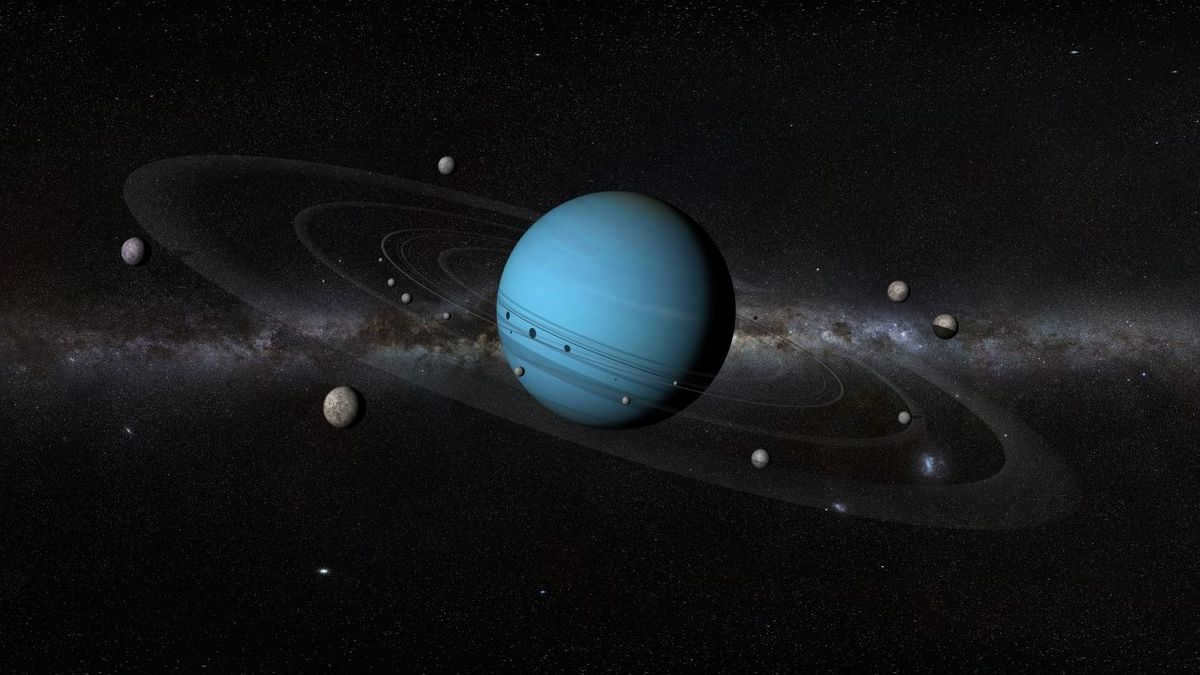
Uranus is a gas giant that lacks a solid surface, which means that the reference point for its atmosphere is a layer with a pressure of 1 bar. However, there are layers located 300 kilometers below this point that are accessible for studying Uranus’ atmosphere.
Uranus possesses the coldest atmosphere in the entire solar system, with an average temperature of -220 C.
The only spacecraft to have come close to Uranus is Voyager 2, which flew within 107,000 kilometers of the gas giant in 1986 and transmitted spectral data back to Earth. No other spacecraft have been sent to Uranus.
Observations of Uranus are primarily conducted using the Hubble Space Telescope and ground-based telescopes. The presence of methane vapor and ice crystals surrounding the planet makes studying it challenging, resulting in a limited understanding of many processes occurring in Uranus’ atmosphere.
Due to the presence of methane in the atmosphere of Uranus, the planet appears to have a cool blue hue as it absorbs the red wavelengths of the spectrum.
Distinctive features of Uranus’ atmosphere
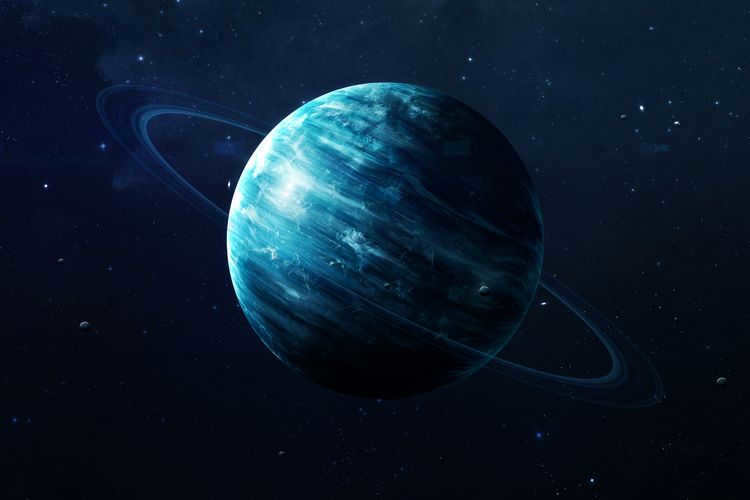
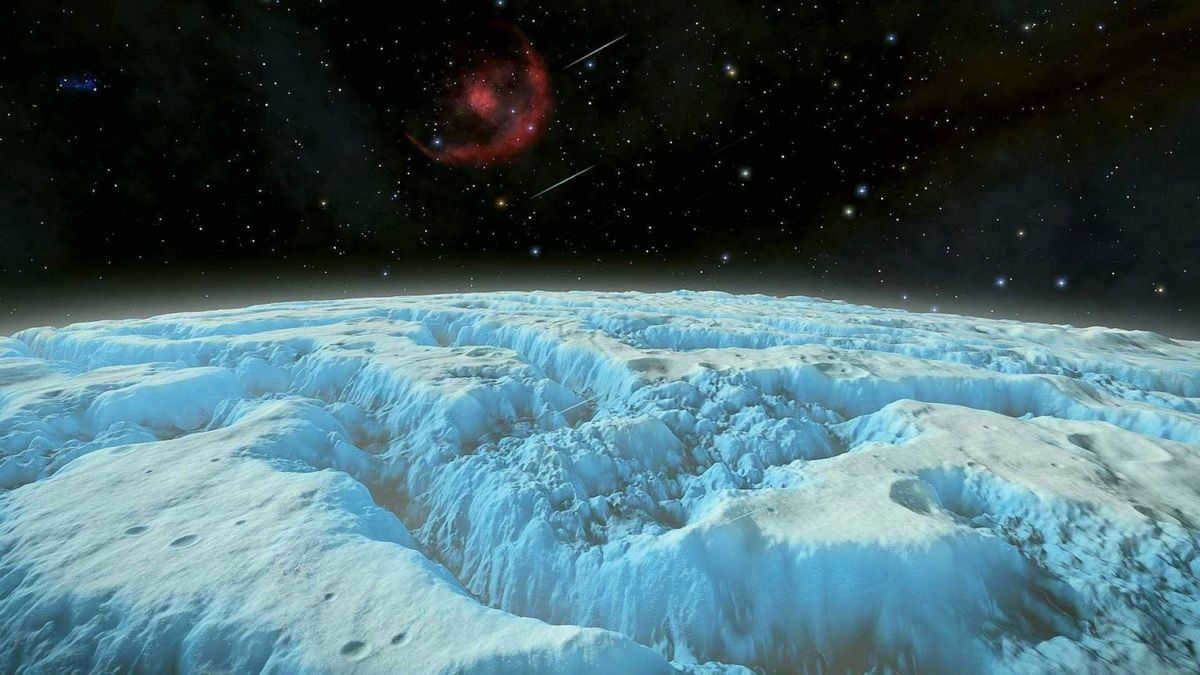
Uranus is known for its methane clouds that conceal storms and other atmospheric phenomena. Although polar lights are a characteristic feature of the planet, they are quite uncommon. The winds on Uranus do not exceed 250 m/s, with the equatorial region experiencing winds of no more than 100 m/s that move in the opposite direction to the planet’s motion.
In the middle latitudes, the movement of air masses aligns with the planet’s motion, with speeds not exceeding 150 m/s. The poles, on the other hand, experience minimal wind.
Overall, Uranus has a relatively calm atmosphere, occasionally exhibiting small vortices in the form of transient dark spots.
Composition
The arrangement or combination of elements in a work of art is known as composition. It is an important aspect of creating a visually appealing and effective piece. Composition involves the placement, balance, and relationship of different elements such as lines, shapes, colors, textures, and space within the artwork.
A well-composed artwork can evoke specific emotions, capture the viewer’s attention, and communicate the artist’s intended message. There are various techniques and principles that artists use to create a strong composition. These include the rule of thirds, leading lines, symmetry, asymmetry, focal point, and visual hierarchy.
The rule of thirds is a widely used composition technique where the artwork is divided into nine equal parts by two horizontal and two vertical lines. The main elements of the artwork are then placed along these lines or their intersections. This creates a sense of balance and harmony in the composition.
Leading lines are another powerful composition technique. They are lines within the artwork that direct the viewer’s eye towards a specific point of interest. These lines can be actual lines within the artwork or implied lines created by the arrangement of elements.
Symmetry and asymmetry are two different approaches to composition. Symmetry is when the elements of the artwork are balanced and mirrored on both sides of a central axis. This creates a sense of stability and order. On the other hand, asymmetry is when the elements are not evenly balanced, creating a sense of movement, tension, or dynamic energy.
The focal point is a dominant element or area within the artwork that draws the viewer’s attention. It can be created through contrast, size, color, or placement. The focal point helps to create a visual hierarchy and guide the viewer’s eye through the composition.
Overall, composition plays a crucial role in the success of an artwork. It is through the careful arrangement and combination of elements that artists can create visually appealing and impactful pieces.
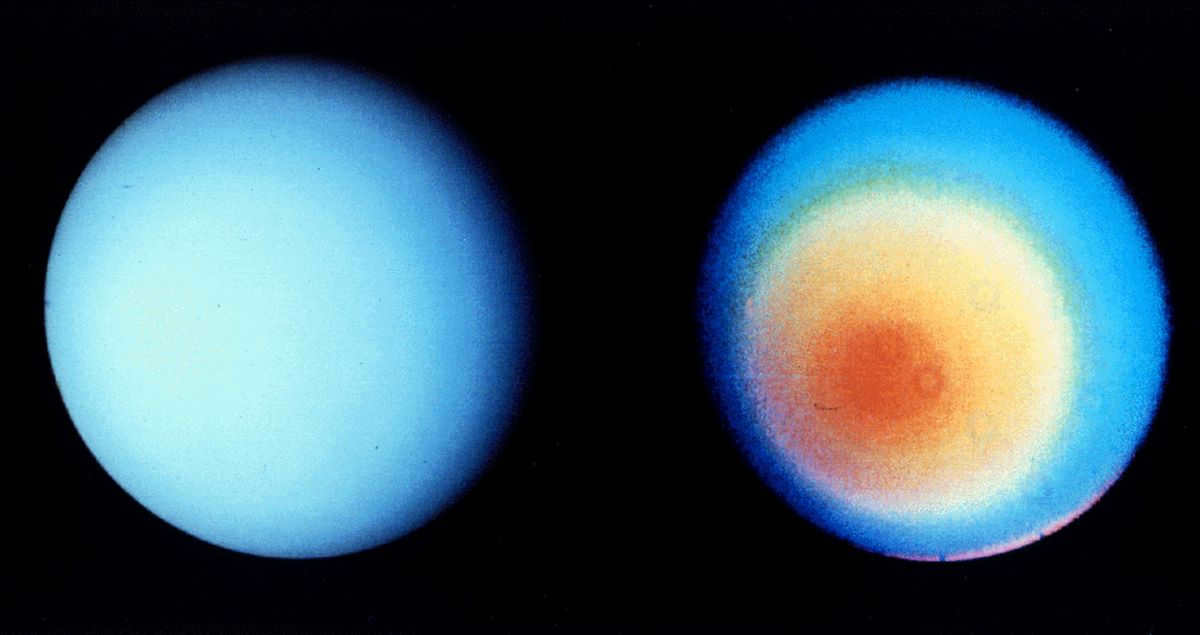
The composition of Uranus’ atmosphere differs from that of the planet:
- The atmosphere of Uranus consists of 83% hydrogen;
- Voyager 2 detected helium in the atmosphere and calculated that it makes up 15% of the total content;
- Methane and acetylene account for the remaining 2%.
Spectroscopy has identified water vapor, carbon monoxide, and carbon dioxide, although these substances are likely brought to the planet by comets and space dust.
Organization

Troposphere (-300 to 50 km)
The troposphere is the lower part of Uranus’s atmosphere. It is characterized by the presence of clouds, winds, and seasonal weather changes. The temperature in this layer starts at approximately 45 degrees Celsius at -300 km and decreases as you move upwards, reaching a low of -220 degrees Celsius. The pressure also decreases from 100 to 1.2 bar.

Stratosphere (50-4000 km)
The layer that comes after the troposphere is called the stratosphere. In the stratosphere, the temperature increases to 550 C. This temperature rise is caused by the absorption of solar radiation by hydrocarbons and its proximity to the thermosphere. At the lower part of the stratosphere, foggy conditions occur due to the presence of ethane and acetylene vapors that cover the entire planet.

Uranus’s Thermosphere (4000 – 50000 km)
Enveloping Uranus at a distance equivalent to two times the radius of the planet. The reason behind its temperature of approximately 600 C remains unknown.
The upper stratosphere and a portion of Uranus’s thermosphere combine to create the ionosphere, which experiences constant fluctuations in density based on solar activity.
Layers of clouds in the atmosphere
Uranus’s atmosphere is divided into distinct layers, each containing different types of clouds that move rapidly:
- The highest and most observable clouds in Uranus’s troposphere are made up of methane. These clouds are located in the layer with a pressure of 1.2 bar.
- Occupying a layer with a pressure of 3-9 bar and a temperature of -170°C, there are clouds composed of ammonia and hydrogen sulfide.
- Within the layer with a pressure of 20-40 bar, there are clouds formed by ammonium hydrosulfide.
- The lowest layer, with a pressure of 50 bar or more, contains clouds made up of ice crystals, which are composed of water.
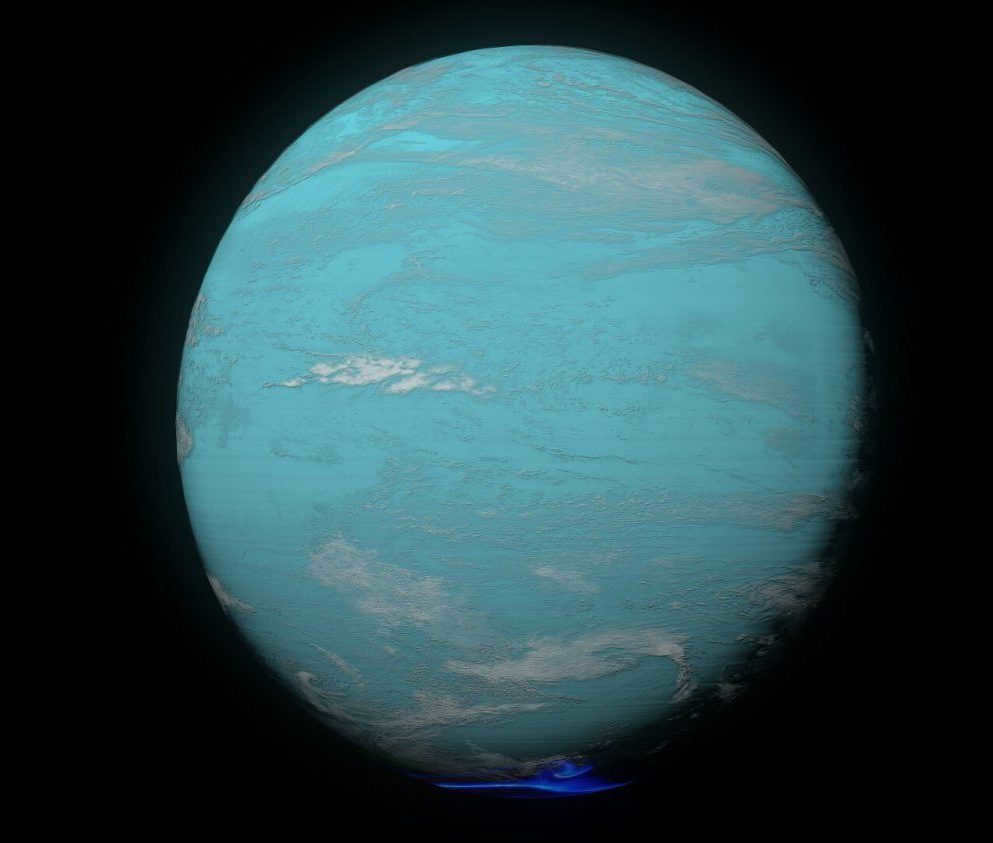
Exploration Background
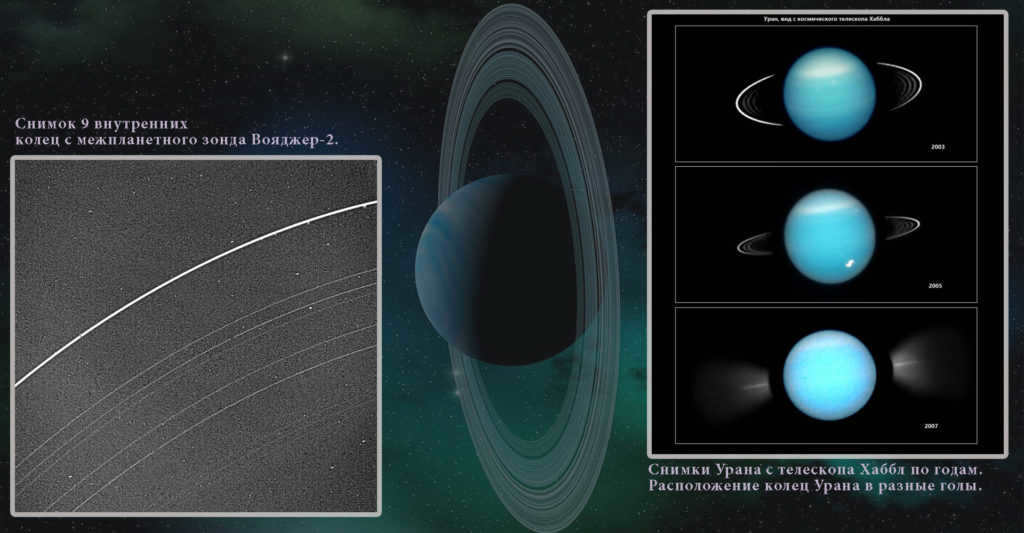
- The study of Uranus began in 1869 when a spectroscope detected mysterious dark bands.
- It was not until 1930 that scientists discovered these bands were actually composed of methane clouds.
- In 1952, further observations revealed the presence of a second element, molecular hydrogen, in Uranus’ atmosphere.
- Since 1967, spectroscopic observations have been used to determine the temperature of this blue giant.
- It was believed until 1986 that only methane and hydrogen existed in Uranus’ atmosphere.
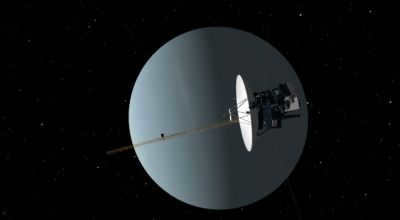
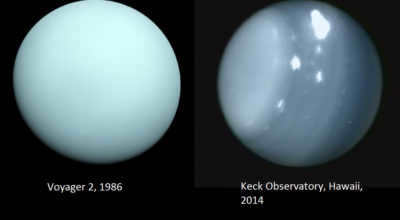
- In 1986, the Uranus was approached by the Voyager 2 spacecraft. It collected spectral data on the blue gas giant and transmitted it back to Earth. The decoded data revealed the presence of helium in the atmosphere of the blue giant and confirmed the existence of previously identified substances.
- Since the 1990s, the movement of clouds has become visible through telescopes equipped with adaptive optics. This has allowed scientists to determine wind speeds and study the atmosphere of Uranus in greater detail.
Responses to Inquiries
There is no mesosphere present on this celestial body.
The region of the thermosphere found at approximately 7000 km altitude is referred to as the exosphere, or alternatively, the hydrogen corona due to its composition.
Despite the fact that the sun warms the planet’s poles more efficiently, it is noticeably warmer at the equator compared to the poles for unknown reasons.
There is a hypothesis proposing that methane decomposes into carbon and hydrogen under the influence of low temperatures. The hydrogen remains in the atmosphere while the carbon undergoes compression, resulting in the formation of diamonds that descend towards the planet’s core.
Watch a video about Uranus
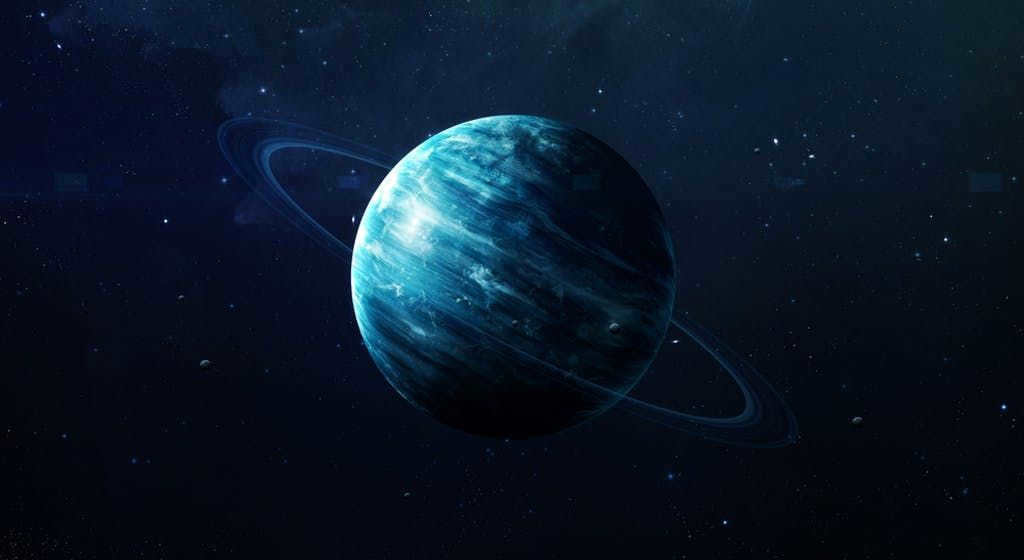

Is it possible for humans to reach the stars and establish colonies on other planets? Queries of this nature ignite a deep desire for exploration.
The atmosphere of Uranus, along with other characteristics of this fascinating planet, serves as a vast field of study. Due to its distance from Earth, Uranus has long been regarded as a mundane and even uninteresting celestial object. However, with new data, scientists are reevaluating their perception of this giant.
The sources of information on Uranus’s atmosphere consist of data transmitted by the Voyager 2 spacecraft and ongoing observations from the Hubble telescope. Although the telescope itself has not undergone modifications, new programs are gradually being developed to extract more precise information from the data it receives.
The composition of the planet’s atmosphere
To better understand the structural characteristics of Uranus’s atmosphere, it is helpful to compare it with the atmosphere of our familiar planet, Earth. On Earth, there is a vast ocean of liquid water and solid land beneath the atmosphere.
However, Uranus, being a gas giant, does not have a solid surface at all. Instead, the “surface” is defined as the point at which the atmospheric pressure is 1 bar, which is equivalent to sea level on Earth.
The atmosphere of Uranus is composed of three distinct layers, each of which is remarkably large:
The troposphere stretches from -300 to 50 km above the surface of Uranus (it’s worth noting that negative altitudes are possible due to the peculiar positioning of Uranus’ “surface” point). Within this 350 km range, the pressure varies from 100 bar at the point closest to the planet’s core to 0.1 bar at the boundary between the troposphere and the stratosphere.
Moving upward, the stratosphere extends from 50 to 4000 km in altitude. Within this region, the pressure gradually decreases from 0.1 to 10-10 bar.
Finally, the thermosphere surrounds the planet at a distance of 50 thousand kilometers, completing this atmospheric parade.
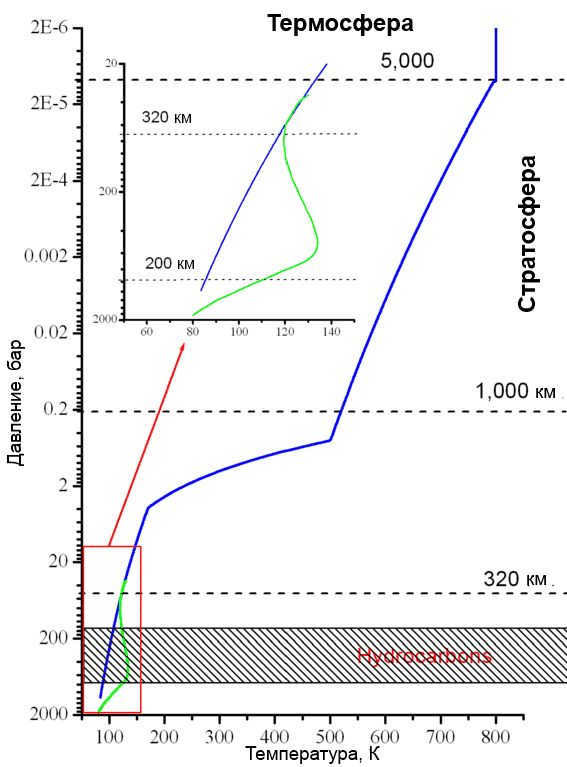
Chemical composition of Uranus’s atmosphere
The primary component of Uranus’s atmosphere is hydrogen, which comprises approximately three quarters of the total gas volume. Additionally, a significant amount of helium is also present.
Interestingly, the mass fraction of helium in Uranus is remarkably similar to that of the Sun.
Methane is another prominent gas in Uranus’s atmosphere. Its presence has long been known due to methane’s chemical properties. Methane absorbs red wavelengths in the visible spectrum, giving Uranus its beautiful aquamarine color when observed from space.
In the lower levels of the atmosphere, which are beyond the reach of current technology, humans are unable to explore. However, there are indications that beyond the veil of hydrogen sulfide and ammonia, there exists an additional layer composed of ammonium hydrosulfide. Furthermore, it is believed that even further out, there are deposits of water in the form of extremely cold supercooled ice.
Only time will reveal whether these speculations by scientists hold true.
Clouds on Uranus
The masses of various gases on Uranus are not stationary. They exist in enormous clouds, some of which are similar to thunderclouds on Earth. Due to their high pressure, these gas masses are highly dense.
The normal winds on Uranus are stronger than the most extreme hurricanes on Earth. On average, the wind speed ranges from 40 to 160 meters per second. The highest recorded gas flow velocity on Uranus is 250 m/s. To put this into perspective, the fastest flows in Earth’s atmosphere move at a speed of 50 m/s.
Observing Uranian clouds is challenging as the planet is located at a significant distance, and one side periodically falls into shadow.
Nevertheless, scientists have discovered that the atmospheric pattern on Uranus changes in a very irregular manner. Some clouds vanish within a few hours, while others remain unchanged for decades.
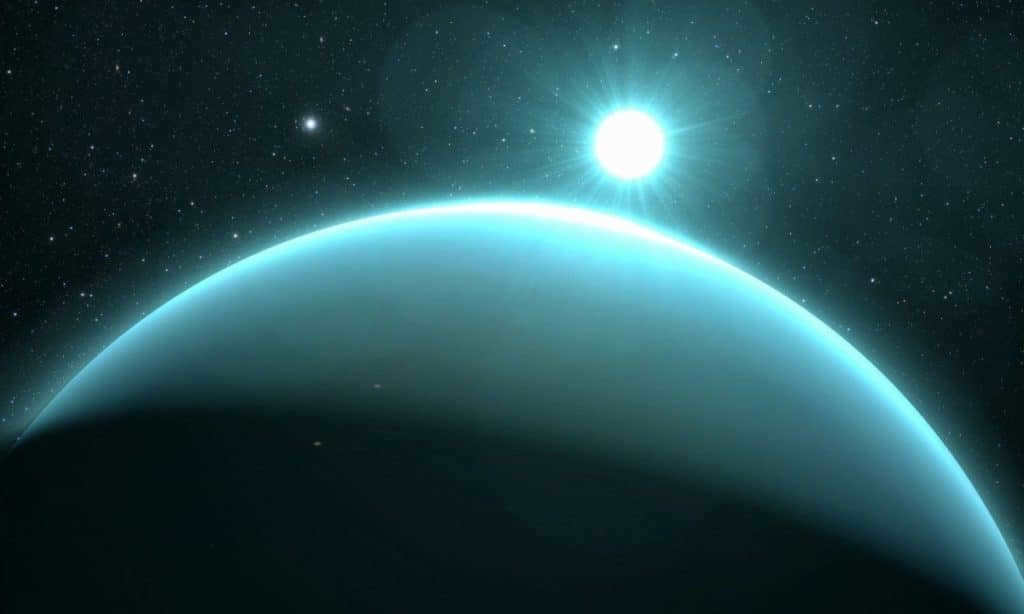
The Temperature of Uranus Planet
The temperature on Uranus planet is an enigma for scientists as its distribution is peculiar. It is worth mentioning that this ice giant possesses the coldest atmospheric conditions among all the planets in the solar system, surpassing even Neptune, which is situated even farther from the Sun.
Based on the available data, the core of this azure giant does not emit any heat. The reason behind this remains a subject of debate among scientists. Some attribute this characteristic to the unconventional rotation of the planet on its own axis.
The average temperature of Uranus can be considered as a relative concept due to its immense size. However, if we focus on the tropopause level, which marks the boundary between the stratosphere and the troposphere, Uranus experiences an extreme temperature of -224 degrees Celsius.
On Earth, we are accustomed to the temperature difference between day and night. Naturally, one might wonder about the temperature variation on the colossal Uranus. Despite its impressive size, Uranus completes a full rotation on its axis in just 17 hours and 14 minutes. As a result, the average temperature remains relatively constant.
Is it possible for life to exist on Uranus?
Based on the existing scientific evidence, it can be argued that it would be highly unlikely for a life form resembling human life to survive on this inhospitable planet.
However, the exploration of the entire solar system, including its individual planets, is still in its early stages. There are many more discoveries to be made by humanity. Could life be found on Uranus? Is it even theoretically possible for life to exist on such planets? Only time will tell. But every great journey starts with a small step, and mankind has already taken that step.
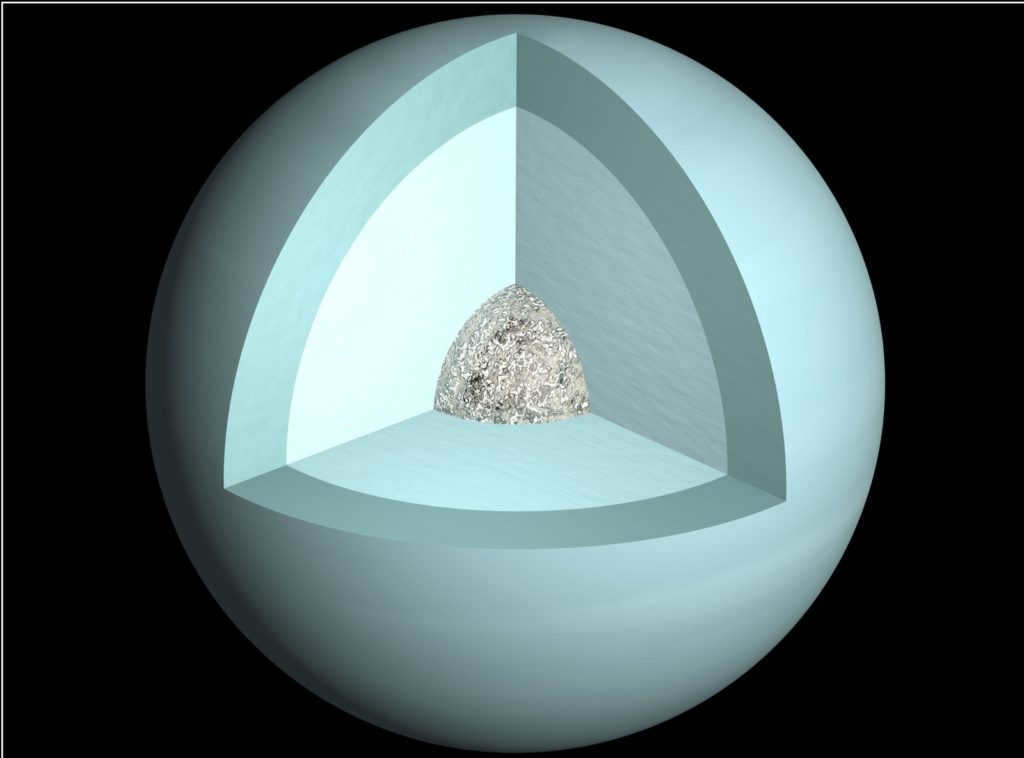
Uranus possesses numerous enigmas. Most of the characteristics of this celestial body render it unique. The structure, composition, and surface of this immense planet are extraordinary.
The genesis of the celestial body
Uranus, which is the seventh planet from the center of the solar system, is located around 3 billion kilometers away from the Sun.
A day on this planet is equivalent to 17 hours and 14 minutes on Earth, while a year lasts 84 Earth years. The lengthy duration of a planetary year is a result of the substantial tilt of this celestial body: it orbits the Sun while lying on its side.
Many astronomers explain this peculiar orientation of the immense planet by hypothesizing that, during its early formation stages, Uranus collided with a massive celestial object, causing it to tilt.
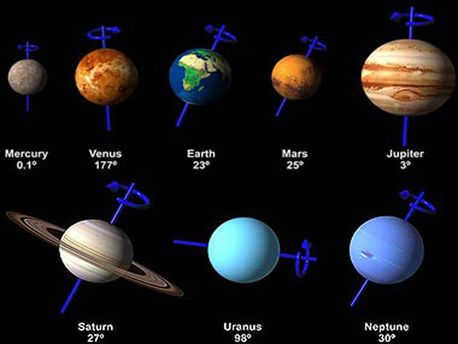
Uranus has a composition of hydrogen, helium, and methane in its atmosphere. The origin of this gas giant remains uncertain. The current theory of planet formation does not fully explain the unique characteristics of Uranus.
The idea of a protoplanet attracting gases and dust particles with its magnetic field does not account for why Uranus is located so far from the Sun, considering its large size.
One of the most puzzling mysteries surrounding Uranus is its lack of heat transfer. Unlike other giant planets that release twice as much solar energy as they receive, Uranus does not release any.
During the formation process, the ice giants in the solar system, including Uranus, did not receive enough residual gas from the protosolar nebula, which explains their relatively low mass compared to their massive size.
Uranus originated from original solids and ice with varying composition, and unlike other gas giants, it lacked the capacity to retain significant quantities of hydrogen and helium.
Is Uranus classified as a planet?
While scientists categorize this celestial object as a gas giant, its characteristics position it somewhere between the gas giants and the terrestrial planets.
An intriguing aspect of Uranus is its rotational direction, which is opposite to that of Earth and most other planets in the solar system. The only other exception is Venus, which shares the same anomalous rotation. The scientific community has yet to provide an explanation for this peculiar rotational behavior.
The following characteristic of this celestial object is that it holds the title for being the coldest within our solar system. It was initially believed that Neptune, being the furthest planet from the Sun, would hold this record, but surprisingly, Uranus is even colder than Neptune. The reason behind this phenomenon remains unexplained.
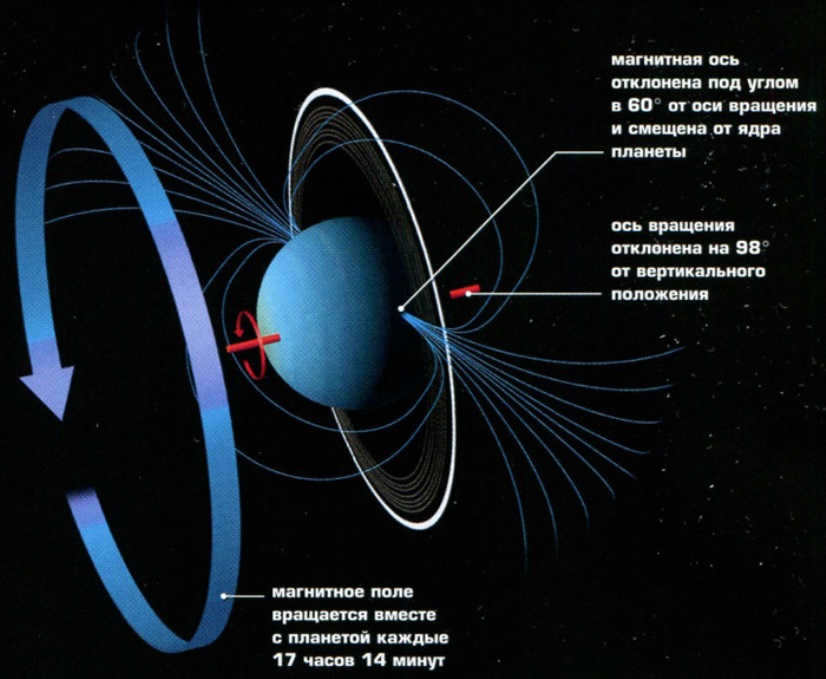
The magnetic field of this celestial object is one of its unique characteristics. It is highly intricate, with four poles and a pronounced tilt in relation to its rotational axis. Unlike other planets, the magnetic poles of Uranus exhibit varying strengths.
In the solar system, Uranus stands out as a peculiar yet unquestionably planetary body.
Planet in focus: Uranus’s composition
Uranus’s composition can be divided into three main components:
The planet is made up of a core and a mantle. The core is composed mainly of rock with traces of ice. Recent research has revealed that the core also contains metals and silicon. Rock accounts for approximately 25% of the planet’s total mass.
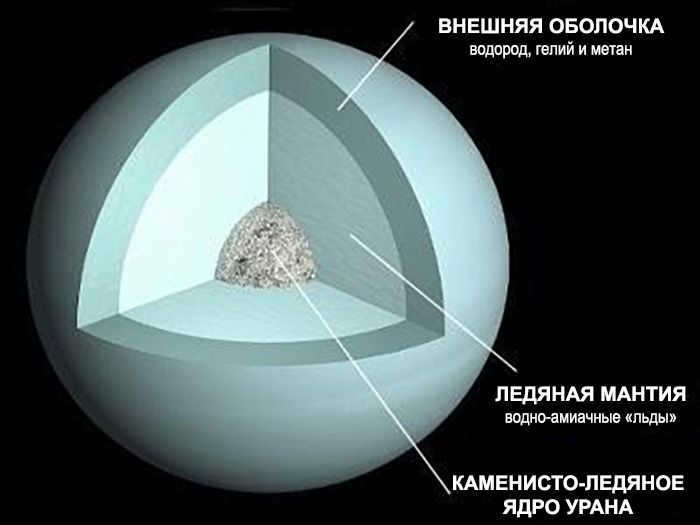
The composition of Uranus is unique, with its mantle being significantly lighter than Earth’s mantle and having a mass 13 times greater. Despite its relatively thin thickness of one thousand kilometers, the mantle is both icy and hot, consisting of a solution of water, ammonia, and methane. Additionally, Uranus’s atmosphere contains a high abundance of hydrogen and helium.
However, there is ongoing speculation within the astronomical community regarding the existence of a nucleus in Uranus. Some believe that it is simply a ball of ice and liquid surrounded by a gas envelope. This celestial body rotates rapidly on its axis, causing it to become flattened at the poles due to the centrifugal force.
With the advancement of computer modeling in the study of celestial bodies, an increasing number of astronomers are coming to the belief that Uranus lacks a core entirely. However, the prevailing orthodox theory among scientists maintains that the planet is indeed composed of rocks at its core.
Measuring at only 20% of the total radius of the celestial body, the core is relatively small. It boasts an intense temperature of 5,000 degrees Kelvin (equivalent to 4726.85 Celsius) and a pressure exceeding 600,000 atmospheres.
Mainly consisting of silicates, the core is enveloped by a layer of ice and rock. Despite the planet’s immense size, its core is comparatively diminutive, even smaller than that of Jupiter.
The Structure of Uranus
Uranus sets itself apart from its larger counterparts, Saturn and Jupiter, in terms of its composition. Unlike them, Uranus lacks metallic hydrogen in its core. Instead, it features numerous peculiar variations of high-temperature ice.
The planet’s atmosphere primarily consists of helium and hydrogen, with ample amounts of ammonia and methane. Additionally, it contains acetylene and other hydrocarbons, surpassing the levels found in Saturn and Jupiter.
Uranus contains a limited amount of light gases, which scientists attribute to anomalies during its formation. When the planet was in the process of developing its core, there was a scarcity of free helium and hydrogen in the solar system.
The composition of Uranus and Neptune significantly differs from that of Jupiter and Saturn, leading to their classification as ice giants.
Helium in Uranus is not located in the planet’s core like other gas giants, but instead, it is concentrated in the atmosphere. The composition of the inner layers of the atmosphere is still not well understood by scientists, but ethane and methylacetylene have been discovered in the upper layers. It is thought that these compounds may be the result of methane undergoing photosynthesis due to the influence of ultraviolet light from the sun.
Additionally, carbon dioxide and carbon monoxide have been detected in the upper atmosphere. Scientists speculate that these gases may be the result of comets passing through Uranus’ atmosphere.
The planet’s density
Uranus possesses an average density of 1.70 grams per cubic centimeter, which is five times less than that of Earth. The planet’s low density can be attributed to the abundance of gases it contains. Uranus has a slightly higher density than Saturn, suggesting the presence of a solid core made up of heavy elements like rocks and metal particles.
The density of the ionosphere varies and relies on the level of solar activity. Compared to other large planets, Uranus experiences relatively weak winds.
The giant planet’s low density can be explained by its unique formation process, during which it primarily accumulated light gases as its main building material.
Gravity and Magnetic Field
Despite its massive size, Uranus has a relatively low density, resulting in a gravitational force on its surface that is comparable to Earth’s gravity. However, the magnetic field of this celestial body is both significant and unpredictable. Scientists have yet to determine the exact sources of this magnetic field’s strength.
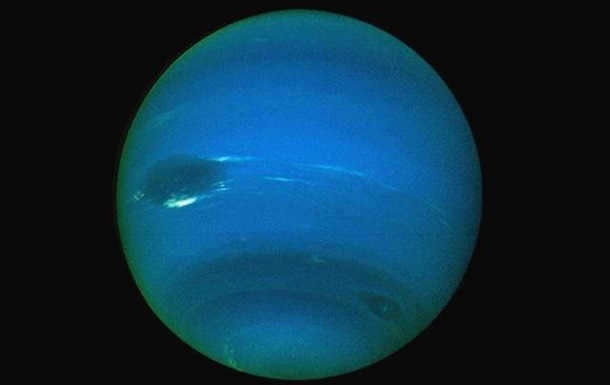
Photographs of the surface relief of Uranus are non-existent. It lacks continents or craters. Astronomers believe that the surface of Uranus is covered with liquid, similar to Earth’s oceans. To reach the solid core, one would have to traverse thousands of kilometers of liquid medium. Consequently, it is impossible for astronauts to land on this planet.
In the images captured by the Voyager spacecraft, Uranus’ surface appears uniform. The clouds surrounding Uranus consist of solid ice and ammonia. Due to the extremely low temperature, the surface appears serene and tranquil, as determined by Voyager during its flyby. Since there is no solid surface in this scenario, scientists consider the atmospheric layer with a pressure of 1 bar as the surface.
The atmosphere of Uranus presents a enigma: in distant regions of this frigid planet’s atmosphere, the temperature soars to colossal values.
Scientists are baffled by the cause of this phenomenon. The warmth observed in the icy planet’s corona is its astounding characteristic.
The celestial body’s cloudiness possesses a multi-layered structure. The primary clouds of the lower layer are composed of hydrogen sulfide. The subsequent layer of clouds is comprised of ammonium salts. Even higher up are clouds consisting of water ice. The condensation of acetylene vapor produces the overcast haze.
There are a total of 10 cloud bands. This was ascertained using the Hubble telescope. This formidable instrument enabled the detection of atmospheric vortices appearing as small patches of dark hue.
What is the color of the planet Uranus?
Let’s explore the appearance of the planet Uranus. When observing space images captured by the Voyager and Hubble telescopes, it is evident that Uranus has a unique blue-green hue. This distinct color is a result of the composition of its atmosphere.
The presence of methane gas within Uranus’ atmosphere is responsible for the vibrant colors. As sunlight penetrates the atmospheric layers, it gets absorbed and reflected by the surrounding clouds, eventually escaping back into outer space.
The upper layer of clouds, primarily composed of methane gas, selectively absorbs the red portions of the light spectrum, resulting in the blue-green tint seen in the scattered sunlight.
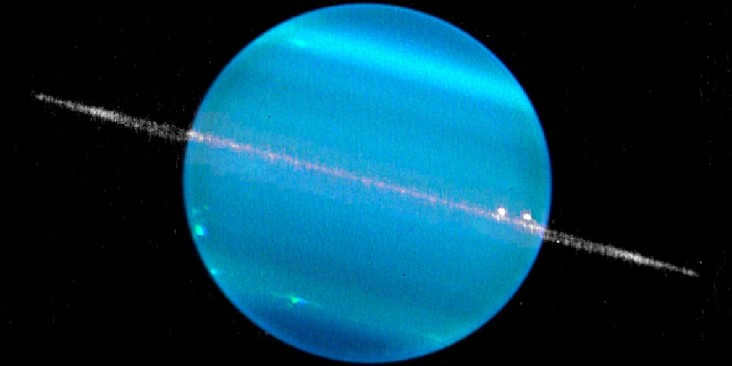
Aside from methane, the atmosphere of Uranus also reflects blue light due to high-altitude photochemical smog. It is possible that there are clouds of different colors in the lower atmosphere, but they are concealed by the presence of methane clouds.
Uranus is often referred to as the “planet of the sea wave” due to its color. Unlike other planets, the clouds of Uranus are not found in its upper atmosphere, but rather in its depths.
The overall color of Uranus is similar to that of Earth, although the giant planet appears paler. While Earth’s blue color is attributed to its vast oceans, the color of Uranus is determined by the unique reflection properties of its clouds.
Recently, a group of astronomers from the United States made an interesting observation regarding the color of the outer ring of Uranus, known as Epsilon. It was previously believed that only Saturn possessed a blue ring, but this new finding challenges that assumption. The blue hue of these rings is attributed to the presence of minuscule particles, each measuring less than a micron in diameter, that have the ability to reflect the blue portion of the electromagnetic spectrum.





